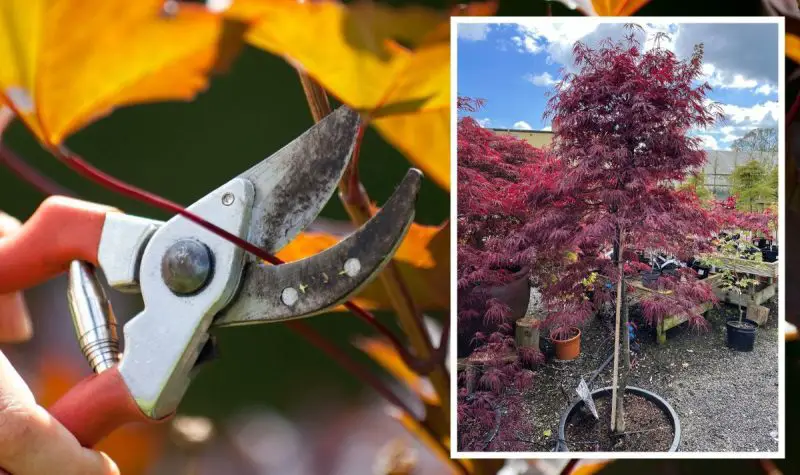Maple trees are admired for their stunning foliage, graceful branches, and the vibrant colors they bring to gardens and landscapes. Proper pruning is essential to maintain their beauty, encourage healthy growth, and prevent potential damage caused by weak or crossing branches. However, knowing the right time and techniques for pruning is crucial to avoid stressing the tree or causing long-term harm.
This guide will explain when to prune maple trees, why timing matters, and how to prune them effectively to keep them strong and visually appealing.
Table of Contents
Understanding the Importance of Pruning Maple Trees

Pruning is more than just cutting branches; it is a way to guide the tree’s growth, remove unhealthy or damaged parts, and improve its structure. For maple trees, pruning helps maintain a balanced canopy, which allows sunlight and air to circulate through the branches. Better air circulation reduces the risk of fungal infections and pest infestations, while sunlight promotes stronger growth and healthier leaves.
Another essential reason for pruning maple trees is to prevent structural problems. Weak, crossing, or closely spaced branches can rub against each other, causing wounds that invite pests and diseases. By removing these problematic branches early, you can help the tree develop a strong framework that supports its natural shape.
The Best Time to Prune Maple Trees
Pruning During Late Winter or Early Spring
The ideal time to prune most maple trees is during late winter or early spring, just before new growth begins. At this time, the tree is still dormant, which reduces the stress caused by pruning. Cutting branches during dormancy also minimizes sap flow, which can otherwise be excessive when the tree is actively growing. Dormant pruning encourages vigorous spring growth, giving the tree a healthy start for the growing season.
Late winter pruning is particularly beneficial for structural shaping. Without leaves on the tree, it is easier to see the branching pattern and make precise cuts. This timing is perfect for removing dead or diseased wood and for thinning overcrowded branches.
Pruning in Summer for Minor Corrections
While late winter is the primary pruning season, light pruning can also be done in mid to late summer. Summer pruning is suitable for controlling rapid growth and improving airflow within the canopy. Since the tree is fully leafed out, it is easier to identify branches that are shading too much of the interior or causing crowding.
Pruning in summer should be minimal because removing too many leaves can reduce the tree’s ability to photosynthesize and store energy for winter. Summer pruning is best limited to small corrective cuts, removing only weak, crossing, or damaged branches.
Avoiding Pruning in Early Spring Sap Flow
Pruning maple trees too early in spring, when the sap starts rising, can cause excessive sap bleeding from the cuts. While sap loss generally does not harm the tree, it can be messy and attract insects. Waiting until the active sap flow slows down or pruning during dormancy can prevent this issue.
Avoiding Late Fall Pruning
Late fall is not a recommended time for pruning maple trees. As the tree prepares for dormancy, cuts made in fall may heal slowly, increasing the risk of disease and cold damage. It is better to wait until winter dormancy to avoid these complications.
Techniques for Pruning Maple Trees Properly
Identifying Which Branches to Remove
Before making any cuts, examine the tree’s overall structure. Look for dead, damaged, or diseased branches that need immediate removal. Branches that cross or rub against each other should also be pruned to prevent injuries to the bark. Lower branches that block pathways or interfere with structures can be removed to maintain a clean shape.
When shaping the canopy, focus on thinning rather than heavy cutting. Removing too many branches at once can stress the tree and lead to weak regrowth. A well-pruned maple tree should have an open, airy canopy that allows sunlight to penetrate evenly.
Making Clean and Proper Cuts
Proper cutting techniques are essential to ensure fast healing and prevent disease. Always cut just outside the branch collar, which is the swollen area where the branch meets the trunk or a larger branch. Cutting too close can damage the trunk, while leaving a long stub can lead to decay. Use sharp, clean pruning shears or saws to make smooth cuts that heal quickly.
For larger branches, use the three-cut method to prevent bark tearing. Make the first cut on the underside of the branch, a few inches away from the trunk, to stop tearing when the branch falls. The second cut should be made from the top, slightly farther out, to remove the branch entirely. Finally, make a clean cut near the branch collar to finish.
Thinning the Canopy for Better Airflow
Thinning is a technique that involves selectively removing branches to open up the canopy. This improves air circulation and reduces the risk of fungal infections. Thinning also allows more sunlight to reach the inner branches, encouraging healthy leaf growth and preventing weak, spindly shoots.
Avoid topping, which means cutting back the entire top of the tree, as this can lead to rapid, weak regrowth and permanent structural problems. Instead, focus on careful thinning to maintain the natural shape.
Shaping for Aesthetic Appeal
Maple trees are naturally elegant, so pruning should enhance rather than drastically change their shape. When shaping, follow the tree’s natural branching pattern and avoid making harsh cuts that disrupt its symmetry. Regular light pruning every few years is better than heavy cutting after long periods of neglect.
Caring for Maple Trees After Pruning
Pruned maple trees need proper care to recover and stay healthy. Watering the tree deeply after pruning helps reduce stress, especially during dry periods. Mulching around the base can help retain moisture and regulate soil temperature, but avoid piling mulch directly against the trunk to prevent rot.
Fertilizing is generally not necessary immediately after pruning, as excessive nutrients can encourage weak, rapid growth. Instead, allow the tree to recover naturally. Monitor the pruned areas for any signs of disease or pest infestation and remove any infected branches promptly.
Common Mistakes to Avoid When Pruning Maple Trees
One of the most common mistakes is over-pruning, which weakens the tree and exposes it to sunscald and diseases. Removing too many branches at once can shock the tree and disrupt its energy balance. Another mistake is improper cutting, such as leaving long stubs or cutting too close to the trunk, which slows healing and increases the risk of decay.
Pruning at the wrong time, especially in late fall or early spring during heavy sap flow, can also lead to unnecessary stress. Always follow seasonal guidelines and prune gradually to maintain the tree’s health and beauty.
FAQs About Pruning Maple Trees
What is the best month to prune maple trees?
The best month to prune maple trees is late February to early March, when the tree is still dormant. This timing reduces stress and encourages healthy spring growth while minimizing sap bleeding.
Can you prune maple trees in summer?
Yes, light pruning in mid or late summer is acceptable for minor corrections. However, avoid heavy pruning because removing too many leaves during the growing season can weaken the tree and reduce its energy production.
Why should you avoid pruning maple trees in fall?
Pruning in fall is not recommended because the tree is entering dormancy, and cuts heal slowly. This slow healing increases the risk of disease and cold damage, which can affect long-term health.
Will pruning hurt the maple tree if done incorrectly?
Improper pruning, such as cutting too close to the trunk, leaving stubs, or removing too many branches, can harm the tree. Always make clean cuts just outside the branch collar and prune gradually to avoid stress.
Do young maple trees need pruning?
Yes, young maple trees benefit from pruning to establish a strong structure early. Light shaping during their first few years helps them grow with a balanced canopy and prevents structural problems in maturity.
Conclusion
Knowing when to prune maple trees and using the right techniques ensures they remain healthy, strong, and visually stunning. Late winter or early spring is the best time for major pruning, while light summer pruning can help with minor corrections. Always focus on thinning for better airflow, removing damaged or crossing branches, and shaping the tree naturally. By following proper pruning practices, your maple trees will continue to thrive and enhance your landscape for many years.






